Floor Screeding Sandy Bedfordshire (SG19): Embarking on a renovation of your Sandy home? Are uneven floors in your living space a concern, or is it about refreshing a dingy cellar? Skilled floor screeding specialists are what you need, the secret to your perfect floor. These talented individuals pave the way for your dream floor (tile, carpet or wood) with a level, smooth foundation, free from limitations. Don't just admire, rely on! This crucial step elevates your floor beyond visual perfection, ensuring the long-lasting durability and strength of your entire structure. Therefore, ensure a successful base with specialist screeding before exploring floor coverings.
FLOOR SCREEDING COMPANIES SANDY
Whatever size room or area you're renovating, a decent floor screeding company in Sandy will supply the experience and correct working methods to generate a perfect base for your floors. They will be able to advise you about the right type of screed your project requires, and how best to apply and install it.
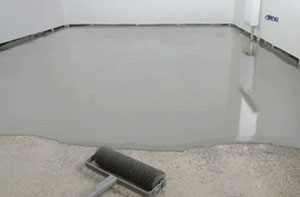
They'll also assess if a structural engineer is needed to make certain any flex strength, point loadings and load bearing are met as laid down in building and construction regulations.
The skills and training that a certified screeding technician brings to your project will guarantee a high quality end result and help in extending the life of your floor. There are numerous kinds of screed and picking the correct mix and laying approach is critical if you are to achieve a quality floor that is fit for purpose and hard-wearing.
Ensure that you get more than one quote for your Sandy based floor screeding project and also ask what standard of finish each estimate is for. The quote may be based on what is known as the SR, or Surface Regularity calculation. SR2 and SR3 might be less expensive options, although the finished floor surface might have deviations and errors, whilst SR1 guarantees a pretty much perfect finish. An SR2 or SR3 level might mean there will be ridges or flat spots that may cause issues when installing your final flooring surface (tile, wood, carpet etc).
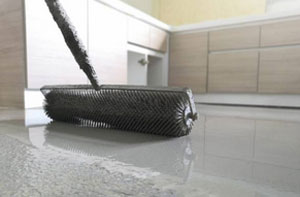
British Standards BS8204 lays down the guidelines and regulations that all Sandy screeding companies must follow, and if using specialist screeding solutions, (Flowcrete, Gypsol, Cemfloor etc), they must be approved by the manufacturers as being trained and skilled in their use. This accreditation program demonstrates a firm's training and high quality performance in the application of a manufacturer's merchandise.
For larger screeding projects in hospitals, factories, schools, shopping centres, warehouses and boutiques, specialist commercial screeders in Sandy will be needed.
TYPES OF SCREED
Standard Screeds - Used in domestic projects where the combination of cement and sand is good for standard floor traffic use. 5 parts sand to 1 part cement is the typical mixture for standard screeds. This 5 to 1 ratio standard screed will set hard at a rate of just 1mm per day after applying.
Fast Drying and Advanced Drying Screeds - If there's a need to use the floor at the earliest opportunity a fast drying screed may be used. Drying at a rate of 3-7mm/day, subject to the mix, they're usually a fibre reinforced kind of screed and are great for flooring projects which have tight deadlines.
Fibre Reinforced Screed - The favoured choice by professional screeders for use with under floor heating systems. The improved flexibility and strength offered by the fibres within this screed mix help protect the resulting floor from thermal shrinkage and cracking. The screed will set hard at a rate of 1mm/day.
Industrial and Heavy Duty Screed - Where levels of traffic are high or heavy loading of the floor is required, heavy duty screeds provide maximum durability and strength.
Polymer Screeds - When a reduced thickness of floor is necessary because of building requirements, a polymer screed provides an extremely high strength resolution to the situation. Polymer screeds are available from a number of manufacturers and due to their diverse chemical compositions have distinct curing times for each individual product.
Self-Levelling or Liquid Screeds - When a high standard of finish is needed this mix of of latex and cement is used to create SR1 quality screeding. This self-levelling compound provides a clean and level surface over a damaged floor or rough substrate to allow all flooring materials to be laid. This liquid screed can be poured to a thickness of only one millimetre, but will still provide a strong surface for a wide range of flooring finishes.
SCREEDING PREPARATION AND INSTALLATION
Good preparation is crucial for a quality finished screed surface that will be hard wearing and durable. The original floor surface should be cleaned to eliminate any paint, oil, debris and grease that might adversely affect the bond of the screed.
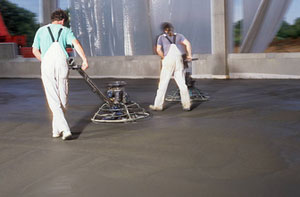
If cleansing products have been used it's important to remove any traces of soap etc, and allow the floor surface to dry naturally. At this stage any cracks need to be repaired as these can easily travel up through the laid screed and be reflected in the completed surface. A trustworthy Sandy screeding specialist will take note of these problems during the site survey and make certain that all preparations are completed before pressing on with the next steps in the floor screeding process.
Before the screeding can be poured a damp proof membrane (DPM) must be installed to shield the screed and final flooring from dampness. Different thicknesses of specialised polythene could be used as a DPM and also act as a barrier for the screed and any insulation material.
Another air-tight barrier may be needed if your home or business premises is in an area that is known to be susceptible to radon. If radon gas occurs in severe doses then a complete ventilation and extraction system may be installed underneath the layer of screed which will remove any gases that might seep in from the ground.
As soon as these steps have been taken the screeders will put on a primer or sealer to the prepared base surface. These primers and sealers will ensure the screed bonds successfully to the floor base and help create a quality finished floor. Because of their specialist nature, only experienced screeding specialists in Sandy are capable of using them correctly, safely and using bespoke equipment for the task.
If you're installing under floor heating, now is the time that it will need to be properly laid out and installed. The cabling and heating pipes are securely attached to insulation panels to stop any movement and make sure that they are held in the correct position. Warmth will be spread evenly across a floor area in a professionally fitted under floor heating system, and with it being an effective method of heating, it's a great choice for many Sandy renovation projects.
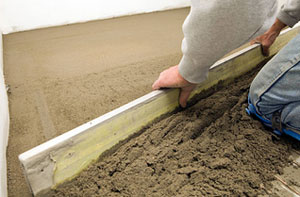
If you are not putting in under floor heating the screed will now be mixed and prepared in situ and laid. Your screeding company will have given you guidance and advice on which screed type is appropriate for your needs, according to your intended use of the room. Remember that even quick drying screeds have a minimum of 24 hours before you can walk over any screeded surface and at least 3 days before any floor coverings can be laid. Manufacturer's drying guidelines for standard and heavy duty screeds must be observed in order to achieve a quality finish and provide an even and stable surface.
The SR standard of your screed can be ascertained once it has solidified sufficiently to be walked upon. Using a two metre straight-edge the surface is examined for any deviations, ridges and dips in the surface of the screed.
- SR1 - Disparities of three millimetres or less being measured over the whole floor area shows your screed to be of the finest quality and categorised as SR1.
- SR2 - If the screeded surface deviates from the straight edge by 5 millimetres or less it is SR2 level and is the normal standard for industrial and commercial floors.
- SR3 - For a utility area or room where the finish is relatively unimportant SR3 is the standard and should have a maximum deviation measurement of 10mm or less.
It may also be necessary for a structural engineer to perform a soundness test. The assessment will make sure that your new screeded surface is suitable for the load bearing requirements specified in the site survey. An assessment called the drop hammer test will be carried out on various areas of the screed and the results recorded. The precise measurement and testing tools needed mean this can only be performed by a fully qualified structural engineer obeying the British Standards BS8204 guidelines. (Tags: Floor Screeding Services Sandy, Floor Screeding Sandy, Floor Screed Sandy, Screeding Sandy).
Floor screeding is available in Sandy and also in nearby places like: Tempsford, Northill, Astwick, Clifton, Cockayne Hatley, Great Barford, Potton, Old Warden, Roxton, Cople, Gamlingay, Biggleswade, Everton, Wilden, Langford, Southill, Abbotsley, Willington, Blunham, and in these postcodes SG19 1BQ, SG19 1JW, SG19 1DR, SG19 1RQ, SG19 1NP, SG19 1ED, SG19 1DB, SG19 1NR, SG19 1DY, and SG19 1BY. Locally based Sandy floor screeders will probably have the postcode SG19 and the telephone dialling code 01767. Checking this should confirm that you are accessing locally based floor screeding. Sandy householders are able to benefit from these and many other floor related services. To make enquiries and obtain screeding quotes, you just need to click on the "Quote" banner.
Damp Proof Membranes
A material known as a DPM (damp proof membrane) is used in construction to stop moisture from seeping into floors, walls, and foundations. It's a polythene or plastic barrier that protects against rising damp, which can cause damage to buildings over the years. The installation of a DPM is crucial for safeguarding a property against moisture-related problems such as decay, mould, and structural weakening.

Commonly found in new buildings, DPMs can also be installed when renovating a property. To block moisture from penetrating, they are frequently installed beneath concrete floors or within walls. This aids in keeping the interior of a building dry, which prevents problems such as damp patches, peeling paint, and warped wooden floors.
Different kinds of DPMs can be found, based on the particular needs of a property. Some, but not all damp proof membranes are self-adhesive; others require a bonding agent for proper installation. Choosing the correct membrane depends on factors including the building's location, the form of construction, and the potential for moisture damage.
All in all, damp proof membranes provide an efficient and easy way to tackle moisture problems. It establishes a long-lasting and durable shield that keeps buildings and homes in Sandy secure from the adverse effects of damp and moisture ingress. To ensure the structure remains dry and fully protected, installing a DPM is an important step, whether you're constructing a new property in Sandy or renovating an existing one. (Damp Proof Membranes Sandy)
Granolithic Screeding
Often necessitated by industrial or commercial applications in Sandy, the method of granolithic screeding provides a surface that is hard-wearing and exceptionally durable. This mixture, comprising cement, sand, and fine aggregate like granite or other tough stone, gives it superior strength and durability compared to typical concrete. This screed is ideal for areas that will experience heavy traffic or machinery, as it withstands wear and tear effectively.
The installation process involves laying the granolithic screed over a prepared base, usually a concrete subfloor. To create a smooth and even surface capable of withstanding heavy use, the screed is meticulously levelled and compacted. It can also be finished with a polished effect, offering not only durability but an attractive, smooth finish for high-traffic areas like warehouses or workshops in Sandy.
Besides its strength, the cost-effectiveness of granolithic screeding is highly regarded. Once installed, it needs minimal maintenance and has a long lifespan, making it an ideal choice for both industrial and commercial environments. Granolithic screeding provides a durable flooring option, whether it's for large residential garages, loading bays, or factories. (Tags: Granolithic Screeding Sandy)
Acid Etching Concrete Sandy
Acid etching is a preparatory process for concrete surfaces before finishing. Acid etching entails applying an water and acid mixture to the concrete to clean and create a rough surface. To ensure a longer-lasting and more durable finish, this helps the sealant or new coating to adhere better.
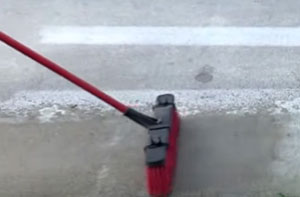
Initially, the concrete surface is thoroughly cleaned to remove any grease, debris or dirt. After cleaning, the concrete surface is evenly covered with the acid solution. Creating a slightly rough texture, the acid reacts with the concrete, improving the bonding properties for paints, sealants, or other products.
When acid etching concrete, safety is paramount because the acid can be hazardous. It is important to don protective gear like goggles, gloves, and a mask to prevent contact with the skin and eyes. For best results, have a professional do it.
Following the acid's job, the concrete is thoroughly rinsed with water to neutralise the acid and get rid of any remaining residue. This prepares the surface for the next stage of the finishing process, be it sealing, staining or painting. (Acid Etching Concrete Sandy)
Latex Floor Screeds
Latex floor screeds are commonly used to create smooth, level surfaces before the final floor coverings are laid. These screeds are easy to apply and flexible, made by combining latex with cement. Latex screeds are specifically designed for uneven or cracked floors, as the latex component enhances adhesion and prevents cracking.
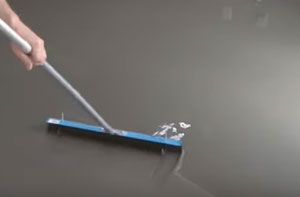
Latex floor screeds can be applied with ease. Cleaning and priming the existing floor is the first step to ensure proper adhesion. The next step involves pouring the latex screed mixture onto the floor and spreading it evenly with a trowel. After drying, this creates a level, smooth surface suitable for vinyl, tiles, or other floor coverings.
A notable benefit of latex floor screeds is their short drying time. Unlike traditional screeds, latex screeds dry within a few hours, allowing for quicker foot traffic. Latex floor screeds are ideal for both commercial and domestic projects where time is of the essence due to their rapid drying time. (Latex Floor Screeds)
Screed Floor Sealing Sandy
Sealing screed floors is an important process performed by professional screeders to protect and enhance their durability. Screed, composed of cement and sand, provides a smooth, level surface perfect for flooring. Sealing is required, however, to keep its integrity and appearance intact. To provide a protective barrier against stains, moisture and wear, a professional will apply a high-quality sealant that penetrates the screed.
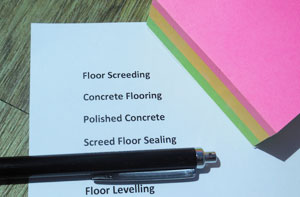
The procedure of sealing starts with a comprehensive cleaning of the screed floor to clear away any dirt, debris or dust. An even coat of sealant is applied to the floor surface, as soon as it is clean and dry. This guarantees that the sealant covers every area, filling in any tiny cracks or pores. Normally, the sealant requires time to dry out and completely cure, creating a durable, long-lasting protective layer.
Improving its appearance and extending its lifespan are achieved by having a specialist seal your screed floor. By giving the floor a smooth, polished finish, the sealing process makes maintenance and cleaning simpler. It also helps prevent damage from heavy foot traffic and spills, making sealing a sound investment for both residential and commercial properties in Sandy. (Screed Floor Sealing Sandy)
Polished Screeds Sandy
For home and property owners in Sandy desiring a sleek and modern flooring solution, polished screeds have emerged as an increasingly popular choice. These floor screeds, characterised by their smooth, trowel-finished surface, offer a robust and visually appealing foundation for an assortment of living spaces. This process achieves a visually impactful and highly practical floor by laying and polishing a cementitious material to a shiney finish.

Polished screed floors are highly advantageous due to their low maintenance requirements. Polished screeds, unlike conventional flooring alternatives, don't need to be waxed or sealed on a regular basis. With a smooth surface that resists dust and allergens, they're an excellent option for people suffering from allergies or asthma. Polished screeds excel in durability, ensuring a long service life and reducing the burden of future replacements and repairs, which can be extremely costly.
Polished screed floors offer homeowners in Sandy the added benefit of flexibility. Customisable to enhance any interior decor or design theme, they come in an array of colours and finishes. Polished screeds can enhance the overall appearance of any Sandy home, whether one decides on an intricate pattern or a more low-key, minimalist design. In addition, their reflective surface can enhance the brightness of spaces by maximising natural light, leading to a more welcoming and open atmosphere. (Polished Screed Floors Sandy)
Screed Reinforcement
Improving the strength and durability of concrete screeds can be achieved by using screed reinforcement. Level surfaces are produced by applying thin, flat layers of concrete to a base layer, known as screeds. Commonly, they are used in building projects as flooring, but they can also function as a finishing layer for ceilings and walls.

To prevent cracking and enhance strength, reinforcement materials like wire, fibres or steel mesh are included in the screed mixture during installation. By distributing load and weight evenly across the surface, reinforcement improves its resistance to thermal changes, impact and abrasion.
Proper installation of the reinforcement is crucial to make certain that it is consistently distributed throughout the screed and does not become displaced over time. To maintain the structural integrity and quality of screeds, it's essential to use screed reinforcement, resulting in a reliable and long-lasting surface for many different applications.
Screed Floor Removal
Pre-existing screed can be removed from a surface through the process of screed floor removal. When undertaking floor upgrades or refurbishments, it is often a necessary step. The removal process requires specialised techniques and equipment to successfully break up and remove the screed layer. This allows for the preparation of the surface for new flooring or other alterations. By specializing in screed floor removal, contractors ensure the safe and efficient removal of the old screed, enabling the floor to start afresh, whether for repairs, upgrades or design variations. (10101 - Floor Screed Removal Sandy)
Floor Screeding Near Sandy
Also find: Biggleswade floor screeding, Clifton floor screeding, Langford floor screeding, Cople floor screeding, Abbotsley floor screeding, Potton floor screeding, Wilden floor screeding, Blunham floor screeding, Southill floor screeding, Old Warden floor screeding, Cockayne Hatley floor screeding, Willington floor screeding, Astwick floor screeding, Great Barford floor screeding, Northill floor screeding, Tempsford floor screeding, Gamlingay floor screeding, Everton floor screeding, Roxton floor screeding and more. Screeding services are available in almost all of these localities. Possessing the expertise and skills required for delivering top-notch flooring solutions, these competent specialists are well-equipped. For both commercial and domestic properties, they're skilled in screeding and make sure that the work is executed to the highest standards. Local residents can get screeding estimates by clicking here.

Other Trades Sandy: Sandy home improvements usually require the expertise of various different craftsmen, and despite the fact that you're currently interested in floor screeding in Sandy, a carpet fitter in Sandy, hardwood flooring in Sandy, roof cleaning in Sandy, partition wall installation in Sandy, roof repairs in Sandy, an underfloor heating specialist in Sandy, a plasterer in Sandy, laminate flooring in Sandy, an electrician in Sandy, a carpenter/joiner in Sandy, a handyperson in Sandy, a plumber in Sandy, garden clearance in Sandy, could also be needed at some stage during your venture. Click on the highlighted links to submit enquiries and get quotes.
Sandy Screeding Related Tasks

There is a variety of work that can be accomplished by your local Sandy floor screeding company including professional floor levelling services, floor screed testing in Sandy, floor renovation, floating screed, subfloor repair, garage floor screeding, decorative floor screeding in Sandy, structural screeds, concrete toppings, liquid screeds, waterproof screeding, sand and cement floor screeding, conservatory floor screeding, granolithic floor screed , self-levelling floor screeding, quick-dry screeds, screed flooring in Sandy, anhydrite screed, sand floor screed, damp proof membranes, underfloor heating screed, floor screeding advice, floor resurfacing, screed floor removal, wet room floors, floor screed aftercare, pumped screeds, floor screeding tools, latex screeds, floor levelling, and more floor screeding tasks. These are just some of the tasks that are handled by those installing floor screeding. Sandy specialists will tell you about their whole range of services.
More: Residential Screeding, Cheap Screeding, Floor Levelling, Screeding Contractors, Self-Levelling Screeds, Residential Screeding, Residential Screeding, Screed Floors, Flooring Contractors, Floor Levelling Services, Residential Screeding, Commercial Screeding, Screeding, Screed Floors, Coloured Screeding, Decorative Screeding, Floor Levelling, Self-Levelling Screeds, Screed Reinforcement, Cheap Screeding, Screed Flooring, Coloured Screeding, Screeding Contractors, Flooring Contractors, Decorative Screeding, Screeding Specialists, Coloured Screeding, Screeding Services, Floor Levelling Services, Floor Screeders, Floor Screeders, Self-Levelling Screeds, Coloured Screeding, Floor Screeders, Concrete Driveway Experts, Driveway Experts, Concrete Driveway Builders.
Floor Screeding Quotes Sandy - Domestic Screeding Sandy - Screeding Sandy - Floor Screeding Near Me - Self-Levelling Screeding Sandy - Floor Screed Contractors Sandy - Industrial Screeding Sandy - Screeder Sandy - Underfloor Heating Sandy


